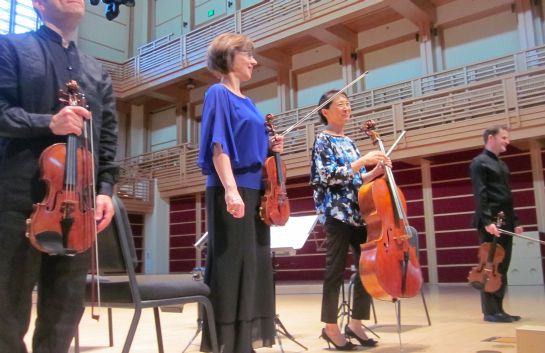|
Chamber
OAKMONT SEASON CLOSES WITH STRAUSS' PASSIONATE SONATA
by Terry McNeill
Thursday, April 11, 2024
Chamber
MORE GOLD THAN KORN AT ALEXANDER SQ CONCERT
by Terry McNeill
Sunday, April 7, 2024
Choral and Vocal
VIBRANT GOOD FRIDAY REQUIEM AT CHURCH OF THE ROSES
by Pamela Hicks Gailey
Friday, March 29, 2024
TWO OLD, TWO NEW AT THE SR SYMPHONY'S MARCH CONCERT IN WEILL
by Peter Lert
Saturday, March 23, 2024
Chamber
NOT A SEVENTH BUT A FIRST AT SPRING LAKE VILLAGE CONCERT
by Terry McNeill
Wednesday, March 20, 2024
THIRTY-THREE PLUS VARIATIONS AND AN OCEAN VIEW
by Terry McNeill
Saturday, March 16, 2024
Choral and Vocal
A ST. JOHN PASSION FOR THE AGES
by Abby Wasserman
Friday, March 8, 2024
Choral and Vocal
SPLENDID SCHUBERT SONGS IN SANET ALLEN RECITAL
by Terry McNeill
Saturday, March 2, 2024
Chamber
SHAW'S MICROFICTIONS HIGHLIGHTS MIRO QUARTET'S SEBASTOPOL CONCERT
by Peter Lert
Friday, March 1, 2024
Chamber
FRY ST. SQ PLAYS A DEMANDING 222 GALLERY CONCERT
by Terry McNeill
Friday, March 1, 2024
|
 |
 Brentano String Quartet Accepting Applause Sept. 30 in Weill Hall |
THORNY BARTOK AND ELEGANT MENDELSSOHN FOR THE BRENTANO
by Sonia Morse Tubridy
Sunday, September 30, 2018
In a minor masterpiece of programming choices the Brentano String Quartet played a Sept. 30 Weill Hall program with an emphasis on refinement, even with a challenging Bartok work in the mix.
Dvorák’s Miniatures for Two Violins and Viola (Op. 75a) opened the concert with charm and gentle loveliness, then folk dance jubilation, profound sadness and finally sighs of lament. The colors were varied and the textures of the three instruments seemed to beguile the attentive audience of 300. The balance and communication of the players was exquisite and powerful in understatement. Czech rhythms appeared in the capriccio, poco allegro and in the romance smooth attacks and deft swelling in short phrases was lovely. Second violin Serena Canin and violist Mischa Amory supported the themes projected by violinist Mark Steinberg in impeccable ensemble with no phrase overplayed and tempos that felt a perfect fit to the music. The performer played standing.
The central work of the program was Bartok’s Second Quartet from 1917, a work inspired by the composer’s travel as an ethnomusicologist in his native Hungary. The first moderato movement opens with the cello leading into dissonant and emotional themes, and the Brentano passed these around, sometimes evoking alienation and at other times shifting from gentle rocking to furious outbursts. There was pain and there was relief. The intensity of this music was sustained which drew from folk traditions, but it’s not folk music in the usual sense, but structural and rhythmic “peasant” music. The second movement (allegro motto capriccioso) was a festival of surging Hungarian dance rhythms. Mr. Steinberg led the wild frenzy which suddenly stops, is tentative, then evolves into a nostalgic waltz, then a gallop with motives from the first movement. The fast and clear passagework in all instruments was riveting and dramatic, especially a thick texture duo from Mr. Amory and cellist Nina Lee.
The third and final lento movement is unusual because traditionally last movements are lively. Here dissonances hover, answered by a sighing cello line and a sense of desolation conveyed by a sad descending violin part. Everywhere the sound had a yearning, looking backward character with wandering unisons, a lovely descending violin phrase from Ms. Canin, and “statements” by both violins that led to “answers” from the cello and viola. Mr. Steinberg’s high register playing had a reference to the Vaughan William’s “Lark Ascending,” and the thorny music an echo of Bartok’s contemporary Pfitzner.
After intermission came Mendelssohn’s Quartet in E flat Major, Opus 44, No. 3, the fifth of his six in the genre.. The allegro vivace is full of excitement, at times restrained, and other times exploding and soaring. Always there are echoes of Beethoven. Repeats were played differently and the knotty first violin part with fistfuls of notes and sixteenth-note passages up high was managed with aplomb by Mr. Steinberg. Clarity here could have been lost wth too much speed, but the Brentano played it admirably with a felicitous tempo. The echt scherzo had proper Mendelssohnian scurrying fantasy and the light attacks in the fugal section breathtaking. The three pizzicato notes at the end were perfectly shaped. The playing in the third movement evoked love in an ever changing form with delicate phrasing, perfect intonation and a planned sense of tentative character. One doesn’t see much inter-musician eye contact with the Brentano, and they are intensely focused on their scores. Key solo playing came from Mr. Amory.
Concluding this quartet and the afternoon’s music the playing of the molto allegro con fuoco soared and and always urged onward, with strong references to the composer’s second cello Sonata, Op. 49 Piano Trio and even the youthful Octet the same key. This is contented and happy music, built carefully in small climaxes. Mr. Steinberg was again the leader here with an agile bow arm, easily conquering the difficulty of playing three sixteenth notes down bow and a single sixteenth note up bow, all the while staying at the same place in the bow and and at a fast pace not making any accents the lone note. The performance had an inevitable quality, gracious and ordered.
Perhaps for some in the hall the playing lacked the big-boned projection of the local hero Parker and Alexander Quartets, but for most the ensemble and elegant musical blend was richly satisfying. A large ovation greeted the exuberant final chord, but there was no encore.
Daniel Greenhouse and Terry McNeill contributed to this review.
|

